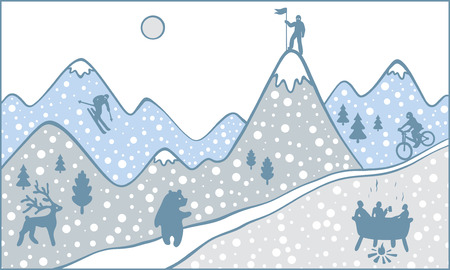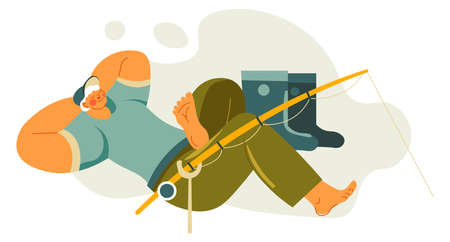1. Understanding the Basics of Baitcasting
Baitcasting is a cornerstone technique for American anglers, prized for its precision and versatility across various fisheries in the United States. At its core, baitcasting revolves around specialized gear—baitcasting reels paired with matching rods, typically featuring a trigger grip and guides placed along the top of the rod blank. This setup offers superior control over lure placement, especially when targeting structure or working heavy cover commonly found in U.S. lakes and rivers.
The key techniques in baitcasting involve thumb control to manage spool rotation during casting, allowing anglers to achieve pinpoint accuracy and minimize backlash. This skill becomes particularly valuable when fishing around docks, laydowns, or submerged vegetation—classic hotspots from Florida’s grassy lakes to California’s reservoir banks.
American anglers favor baitcasting for its ability to handle heavier lines and lures, making it ideal for chasing largemouth bass, pike, and even inshore saltwater species. The robust drag systems and gear ratios of baitcasting reels allow for aggressive hooksets and efficient retrievals, adapting seamlessly to seasonal changes in fish behavior and habitat. Whether flipping jigs in spring or burning spinnerbaits in fall, baitcasting stands out as the go-to system that lets anglers adapt their presentations as conditions shift throughout the year.
Spring Transitions: Finding Pre-Spawn and Spawn Patterns
As winter loosens its grip across the United States, anglers everywhere look forward to the dynamic opportunities that spring brings. Warming waters trigger dramatic changes in fish behavior, especially for popular gamefish like bass, crappie, and walleye. Understanding these seasonal transitions is key to successful baitcasting during this period of rapid change.
Understanding Spring Water Temperature Milestones
Fish species react differently as water temperatures rise. Across various U.S. regions, pre-spawn and spawn periods can vary by weeks or even months due to local climate differences. The following table highlights typical temperature ranges for key spring milestones:
| Species | Pre-Spawn Temp (°F) | Spawn Temp (°F) | Regions Most Affected |
|---|---|---|---|
| Bass (Largemouth/Smallmouth) | 48–55 | 60–75 | Southeast: Early March; Midwest/North: April-May |
| Crappie | 50–58 | 62–68 | Southeast: Late Feb-March; North: April-May |
| Walleye | 38–44 | 42–50 | Northern states: Ice-out to May; Great Lakes: April-May |
Baitcasting Tactics by Region and Species
Southeast: Waters warm earlier here. Look for bass moving shallow on sunny days, targeting cover near spawning flats with spinnerbaits or jigs. Crappie will stage around brush piles before flooding shallow timber to spawn. Walleye are less common but often found below dams or in river systems.
Midwest: As ice thaws, focus on north-facing banks that warm up fastest. Bass respond well to slow-rolled swimbaits or jerkbaits, while crappie gather near submerged structure before making their shallow push. Walleye chase baitfish along rocky points—try lipless crankbaits or jig-and-minnow combos.
Northern States/New England: Spring arrives late, so be patient. Once water temps creep above 45°F, bass and crappie begin migrating toward spawning areas. Use suspending jerkbaits and finesse jigs for lethargic fish. Walleye action peaks right after ice-out—focus on current breaks and gravel bars.
General Tips for Spring Baitcasting Success
- Monitor water temperature closely—small increases can trigger big movements.
- Select baits that mimic local forage and match the fish’s activity level.
- Pay attention to weather swings; cold fronts may push fish back deeper temporarily.
- Keep your presentation slower in cooler water, speeding up as temperatures rise.
The Takeaway
Tuning into regional cues and understanding how warming trends affect each species will help you capitalize on the best spring bite windows no matter where you fish in the U.S. Adapting your baitcasting approach throughout these transitions is the key to unlocking consistent catches as winter gives way to spring.

3. Summer Tactics: Adjusting for Heat and Changing Water Levels
When summer hits across the United States, baitcasting anglers face a unique set of challenges. High temperatures and dropping water levels can significantly affect fish behavior, making it essential to fine-tune your approach if you want to stay productive. The key is capitalizing on high-activity periods—typically early morning and late evening—when bass and other gamefish move into shallower, cooler water to hunt.
Maximizing Early and Late Windows
During summer, fish often become lethargic during the midday heat, but they ramp up activity at dawn and dusk. Targeting these windows with topwater baits like walking frogs or poppers can yield explosive strikes as bass feed aggressively in the low light. In many Southern lakes and reservoirs, buzzbaits and spinnerbaits fished parallel to weed lines or docks are also highly effective right before sunrise or just after sunset.
Fine-Tuning Your Retrieve
With increased angling pressure during summer weekends, fish quickly become wary of standard presentations. To outsmart pressured fish, experiment with retrieve speeds and cadences. Slowing down your retrieve with soft plastics, like Texas-rigged worms or creature baits, can entice bites from reluctant bass holding tight to cover. On the flip side, an erratic jerkbait or crankbait retrieve can trigger reaction strikes from aggressive fish that have seen it all.
Adapting to Regional Differences
Don’t forget that summer patterns vary regionally. In northern states where water stays cooler, fish may remain active longer into the day compared to their southern counterparts. In Western reservoirs with fluctuating water levels, focus on newly submerged structure or rock piles exposed by receding shorelines. Always keep an eye on local conditions—adjusting your tactics is crucial for consistent success as you follow seasonal baitcasting patterns across America.
4. Fall Patterns: Capitalizing on Feeding Frenzies
As autumn settles in, baitfish migrations become the driving force behind some of the most aggressive bass feeding behavior youll see all year. Across the United States, understanding how these migrations play out regionally is essential to maximizing your success with a baitcasting setup.
Insights on Baitfish Migrations
Baitfish like shad and shiners begin moving from deeper water toward creeks, coves, and shallower bays as water temperatures drop. Bass closely follow these schools, positioning themselves to ambush prey. In the Midwest, look for these movements in larger reservoirs and natural lakes, especially where wind pushes bait into pockets. Down in the Deep South, massive shad migrations can trigger intense surface activity in river systems and impoundments.
Key Lure Choices for Fall
Your lure selection should mimic local baitfish both in appearance and action. Here’s a quick breakdown of top fall lures by region:
| Region | Lure Type | Color Pattern | Presentation Tips |
|---|---|---|---|
| Midwest | Lipless Crankbaits, Spinnerbaits | Shad or Silver/Blue | Burn through shallow flats and creek mouths |
| Northeast | Jerkbaits, Swimbaits | Natural Baitfish (Ayu, Ghost) | Paus-and-go retrieve near structure |
| Southeast & Deep South | Topwaters (Walking baits), Squarebill Cranks | White or Chrome | Target schooling activity at dawn/dusk along points and ledges |
| West Coast | Underspins, Soft Plastics | Pearl or Smelt colors | Slow-roll through grass lines and rocky transitions |
Region-Specific Approaches: Midwest to Deep South
Midwest: Focus on wind-blown banks where bait piles up; bass often stage just outside visible cover waiting for opportunities.
Deep South: Follow bait balls using electronics—large groups of bass will corral shad into tight schools. Don’t overlook river backwaters that get re-oxygenated during the fall drawdown.
Northeast & West: Seek out steep banks adjacent to flats—baitfish use these as migration highways and bass are never far behind.
Tactical Adjustments for Success
Baitcasting Gear: Use reels with faster gear ratios (7:1 or higher) to quickly pick up slack during fast retrieves and capitalize on reaction strikes.
Lure Size: Match the hatch—downsizing can be crucial when bass are keyed in on smaller baitfish late in the season.
The Bottom Line
No matter your region, fall is about covering water and reacting to dynamic conditions. Keep your eyes open for surface busts, bird activity, and subtle changes in water clarity—all signs that a feeding frenzy could erupt at any moment.
5. Winter Approaches: Finesse and Slow Presentations
As winter settles in across the United States, baitcasting strategies shift dramatically to match the lethargic nature of cold-water bass and other game fish. American anglers know that when water temperatures drop, metabolism rates slow, making fish less aggressive and more reluctant to chase fast-moving baits. This is where finesse tactics and slow presentations become essential tools in any baitcaster’s playbook.
Gear Adjustments for Cold-Weather Baitcasting
One of the first steps experienced anglers take as winter approaches is downsizing their gear. Switching to lighter line—often 8-12 lb fluorocarbon—can make a huge difference in getting bites from wary fish. Many also opt for sensitive rods with soft tips, allowing better detection of subtle strikes common in frigid conditions. Reel adjustments are key too; lowering your reel’s gear ratio (for example, using a 5.4:1 instead of a 7:1) helps maintain a slower, more controlled retrieve that’s attractive to sluggish fish.
Slow-Rolled Presentations That Get Results
During winter, slow-rolled techniques dominate the American baitcasting scene. A classic approach involves crawling a jig or a Texas-rigged soft plastic along the bottom, pausing frequently to let the lure sit motionless—a method that mimics an easy meal for inactive fish. Another popular tactic is the slow-roll spinnerbait presentation, where anglers retrieve just fast enough to keep the blades turning, barely above the bottom structure. Both methods focus on maximizing time in the strike zone while minimizing movement to entice bites from even the most unmotivated bass.
Embracing Patience and Precision
The hallmark of successful winter baitcasting across the U.S. is patience. Casts are made with purpose, targeting deep holes, rocky points, and submerged timber where fish tend to stack up for warmth. Anglers meticulously pick apart these areas, making repeated casts and working their lures painstakingly slow. Mastering these techniques not only increases your odds during tough winter months but also sharpens overall angling skills—an approach deeply respected among seasoned American fishermen.
6. Regional Variations: Adapting to Local Waters
One of the most crucial aspects of successful baitcasting across the United States is understanding how seasonal strategies must be fine-tuned for local conditions. American fisheries are incredibly diverse, from sprawling southern reservoirs to winding northern rivers and pristine western lakes. Each region presents its own set of variables—water clarity, forage species, temperature swings, and even angler pressure—all of which impact bass behavior throughout the year.
Lakes: Northern vs. Southern Approaches
Consider the difference between a deep, clear northern lake like Minnesota’s Mille Lacs and a weedy, shallow southern powerhouse such as Texas’ Sam Rayburn Reservoir. Early spring in Mille Lacs may call for finesse presentations—think light line and subtle jigs—since cold water keeps bass sluggish. In contrast, at Sam Rayburn, rising water temps and abundant vegetation demand reaction baits like lipless crankbaits or spinnerbaits to trigger bites from more aggressive pre-spawn fish.
Rivers: Current Dictates Tactics
River systems like the Tennessee River chain or Wisconsin’s Mississippi backwaters add another layer of complexity. Seasonal current flow in spring and fall positions bass behind current breaks or near eddies. Here, casting upstream with compact jigs or swim baits lets your lure move naturally with the flow—a tactic that differs significantly from still-water approaches. During summer low water, flipping creature baits into heavy cover becomes a go-to move on these rivers.
Reservoirs: Fluctuating Water Levels
Reservoirs across the Midwest and Southeast often experience significant water level changes due to rain or dam operations. For example, at Alabama’s Lake Guntersville, a sudden rise in water can push bass shallow into flooded brush during spring, calling for pitching soft plastics to tight cover. Conversely, dropping levels in late summer might concentrate fish around deeper main-lake points where deep-diving crankbaits shine.
Practical Takeaways from Notable Fisheries
Across all these waters, adapting your baitcasting strategy seasonally is about reading the local cues. On Florida’s Lake Okeechobee, look for spawning beds in early spring and slow-roll swimbaits over hydrilla mats. In California’s Clear Lake during post-spawn, target docks and rocky banks with vibrating jigs as bass recover from spawning stress. The key is paying attention to how regional characteristics shape fish patterns and being willing to adjust your tackle and techniques accordingly.
Bottom Line
No two bodies of water are exactly alike, so embracing regional variations isn’t just smart—it’s essential if you want consistent success throughout the year. Study your local fishery’s quirks, experiment with proven seasonal tactics, and don’t hesitate to tweak your approach based on real-time conditions.
7. Pro Tips and Common Mistakes
Hard-Earned Advice from Local Pros
No matter where you fish in the U.S., seasoned baitcasters agree: success comes from paying close attention to local conditions and being willing to adapt. In Florida’s heavy cover, for example, pros recommend using braided line for extra strength. Out West, clear reservoirs often call for finesse presentations and lighter fluorocarbon leaders. Across the Midwest, dialing in reel settings to match windy spring conditions can mean the difference between a productive outing and endless backlashes. Take time to talk with local anglers or visit bait shops for up-to-the-minute advice—these small insights often lead to big results.
Common Pitfalls in Seasonal Baitcasting
Ignoring Water Temperature Shifts
One of the most frequent mistakes is failing to track water temperature changes that trigger fish behavior shifts. For instance, pre-spawn bass in southern lakes react very differently compared to post-spawn smallmouths in northern rivers. Adjust your lure selection and retrieval speed accordingly.
Overlooking Weather Patterns
Many anglers neglect how cold fronts or sudden warm-ups affect fish positioning and feeding activity. Always check the forecast and be ready to change tactics—sometimes even mid-trip—to stay on active fish.
Sticking to “One Size Fits All” Tactics
A Texas rig might dominate in the South during summer but fall flat on New England’s pressured waters. Don’t be afraid to experiment with lure color, size, and presentation based on seasonal cues specific to your region.
Final Thought
The most successful baitcasters across America are those who never stop learning—from both their own mistakes and the wisdom of others. Stay curious, keep adapting, and you’ll find yourself ahead of the game no matter what season—or state—you’re fishing in.

